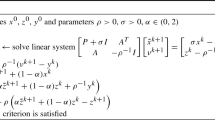Abstract
The Projected Aggregation methods generate the new point x k+1 as the projection of x k onto an “aggregate” hyperplane usually arising from linear combinations of the hyperplanes defined by the blocks. The aim of this paper is to improve the speed of convergence of a particular kind of them by projecting the directions given by the blocks onto the aggregate hyperplane defined in the last iteration. For that purpose we apply the scheme introduced in “A new method for solving large sparse systems of linear equations using row projections” [11], for a given block projection algorithm, to some new methods here introduced whose main features are related to the fact that the projections do not need to be accurately computed. Adaptative splitting schemes are applied which take into account the structure and conditioning of the matrix. It is proved that these new highly parallel algorithms improve the original convergence rate and present numerical results which show their computational efficiency.
Similar content being viewed by others
References
R. Aharoni and Y. Censor, Block-iterative projection methods for parallel computation of solutions to convex feasibility problems, Linear Algebra Appl. 120 (1989) 165–175.
R. Bramley and A. Sameh, Row projection methods for large nonsymmetric linear systems, SIAM J. Sci. Statist. Comput. 13 (1992) 168–193.
Y. Censor, D. Gordon and R. Gordon, Component averaging: an efficient iterative parallel algorithm for large and sparce unstructured problems, Technical Report, Department of Mathematics, University of Haifa, Israel (1998) (accepted for publication in Parallel Computing).
Y. Censor and S. Zenios, Parallel Optimization: Theory and Applications (Oxford University Press, New York, 1997).
G. Cimmino, Calcolo approssimato per le soluzioni dei sistemi di equazioni lineari, Ric. Sci. 16 (1938) 326–333.
U.M. García-Palomares, Parallel projected aggregation methods for solving the convex feasibility problem, SIAM J. Optim. 3 (1993) 882–900.
L.G. Gubin, B.T. Polyak and E.V. Raik, The method of projections for finding the common point of convex sets, USSR Comput. Math. and Math. Phys. 7 (1967) 1–24.
A. Iusem and A. De Pierro, Convergence results for an accelerated nonlinear Cimmino algorithm, Numer. Math. 49 (1986) 367–378.
S. Kaczmarz, Angenäherte Auflösung von Systemen linearer Gleichungen, Bull. Intern. Acad. Polonaise Sci. Lett. 35 (1937) 355–357.
H.D. Scolnik et al., A new method for solving large sparse systems of linear equations using row projections, in: Proceedings of IMACS International Multiconference Congress Computational Engineering in Systems Applications, Nabeul-Hammamet, Tunisia, 1998, pp. 26–30.
H.D. Scolnik et al., A class of optimized row projection methods for solving large non-symmetric linear systems, Report Notas de Matemática-74, Department of Mathematics, University of La Plata (2000), to appear in Applied Numerical Mathematics.
Author information
Authors and Affiliations
Rights and permissions
About this article
Cite this article
Scolnik, H., Echebest, N., Guardarucci, M. et al. Acceleration Scheme for Parallel Projected Aggregation Methods for Solving Large Linear Systems. Annals of Operations Research 117, 95–115 (2002). https://doi.org/10.1023/A:1021565305371
Issue Date:
DOI: https://doi.org/10.1023/A:1021565305371




